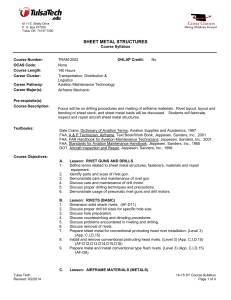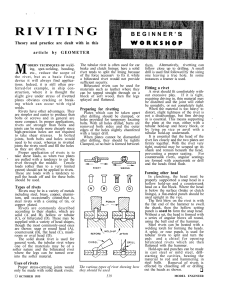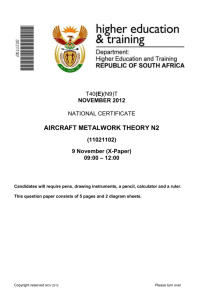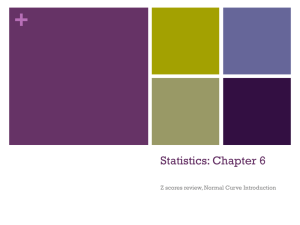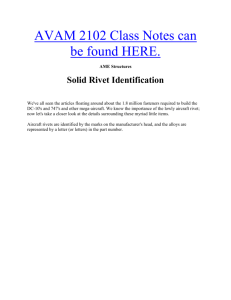CENTRAL TEXAS COLLEGE
advertisement
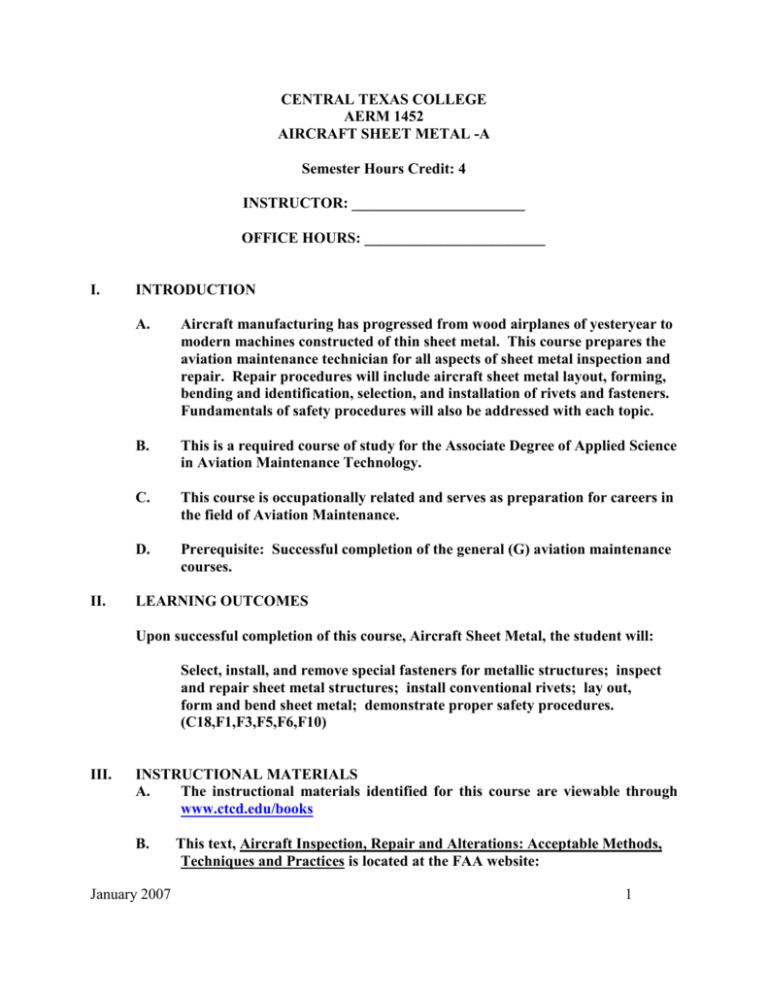
CENTRAL TEXAS COLLEGE AERM 1452 AIRCRAFT SHEET METAL -A Semester Hours Credit: 4 INSTRUCTOR: _______________________ OFFICE HOURS: ________________________ I. II. INTRODUCTION A. Aircraft manufacturing has progressed from wood airplanes of yesteryear to modern machines constructed of thin sheet metal. This course prepares the aviation maintenance technician for all aspects of sheet metal inspection and repair. Repair procedures will include aircraft sheet metal layout, forming, bending and identification, selection, and installation of rivets and fasteners. Fundamentals of safety procedures will also be addressed with each topic. B. This is a required course of study for the Associate Degree of Applied Science in Aviation Maintenance Technology. C. This course is occupationally related and serves as preparation for careers in the field of Aviation Maintenance. D. Prerequisite: Successful completion of the general (G) aviation maintenance courses. LEARNING OUTCOMES Upon successful completion of this course, Aircraft Sheet Metal, the student will: Select, install, and remove special fasteners for metallic structures; inspect and repair sheet metal structures; install conventional rivets; lay out, form and bend sheet metal; demonstrate proper safety procedures. (C18,F1,F3,F5,F6,F10) III. INSTRUCTIONAL MATERIALS A. The instructional materials identified for this course are viewable through www.ctcd.edu/books B. January 2007 This text, Aircraft Inspection, Repair and Alterations: Acceptable Methods, Techniques and Practices is located at the FAA website: 1 http://www.airweb.faa.gov/Regulatory_and_Guidance_Library/rgAdvisoryC ircular.nsf/0/99C827DB9BAAC81B86256B4500596C4E?OpenDocument C. IV. References: Dale Crane, Airframe Test Guide 2005 Edition USA, Aviation Supplies & Academics, Inc. 2004 (ISBN 1-56027-535-9) COURSE REQUIREMENTS The following will be required of each student for successful completion of this course: V. VI. A. Reading Assignment: Students are required to complete all reading assignments prior to the class in which the materials will be discussed. Students are subject to announced and unannounced written and oral examinations on assigned reading material. B. Projects: See projects 1-10 listed after Modules one and two. Projects will be assigned based on instructor’s discretion and availability of resources. C. Class performance: Students are required to attend all classes and to be in the classroom on time. The instructor can lower a student’s grade because of excessive tardiness. When absent from class for any reason, it is the student’s responsibility to arrange for and make up assignments missed during the absence. D. Class Participation: Students will earn a satisfactory grade in the course by attending and regularly participating in class, giving complete attention to class activities, completion of all assigned work and successfully completing the examinations. Students are required to maintain a minimum GPA of 2.0 to receive a passing grade for the class and are encouraged to compute and monitor their GPA as the class progresses. EXAMINATIONS A. There will be two written examinations for this course covering all the lecture notes and reading material. B. Practicum: 10 projects will be assigned to each student, based on the availability of resources. SEMESTER GRADE COMPUTATION EXAMINATIONS EXAM 1 EXAM 2 AERM 1452 POINTS 400 400 POINT TO GRADE RATIO 900- 1000 = A 800- 899 = B 2 Practicum/Projects 1-10 TOTAL 1000 VII. 200 700- 799 = C 600- 699 = D 0- 599 = F NOTES AND ADDITIONAL INSTRUCTIONS FROM COURSE INSTRUCTOR A. Course Withdrawal: It is the student’s responsibility to officially drop a class if circumstances prevent attendance. In order to be officially withdrawn from the course, a student must obtain, complete and file an Application for Withdrawal form with the College. The student’s transcript will show “W” or “F”, depending on whether the student was passing or failing at the time of withdrawal. B. Administrative Withdrawal: Students not meeting course objectives or not making satisfactory progress may be withdrawn from the course at the discretion of the instructor. C. Cellular Phones and Beepers: Cellular phones and beepers will be turned off while the student is in the classroom or laboratory. D. American’s with Disabilities Act (ADA): Disability Support Services provide services to students who have appropriate documentation of a disability. Students requiring accommodations for class are responsible for contacting the Office of Disability Support Services (DSS) located on the central campus. This service is available to all students, regardless of location. Explore the website at www.ctcd.edu/disability-support for further information. Reasonable accommodations will be given in accordance with the federal and state laws through the DSS office. E. Instructor Discretion: The instructor reserves the right of final decision in course requirements. F. Civility: Individuals are expected to be cognizant of what a constructive educational experience is and respectful of those participating in a learning environment. Failure to do so can result in disciplinary action up to and including expulsion. VIII. COURSE OUTLINE A. Module One: Metallic aircraft structural methods 1. AERM 1452 Learning Outcomes: upon successful completion of this module, the Student will: 3 a. Identify types of metallic aircraft structures b. Explain stresses acting on aircraft structures c. Discuss nonferrous metals and heat treating methods d. 2. Explain ferrous metals and strength measuring methods. Learning Activities: Successfully complete examination 1 covering material presented in Module 1. (F1,F5,F10) 3. Equipment and Materials: Rivets universal, countersunk, round head, and flat head, assortment of blind rivets, friction locks cherry rivets, mechanical lock cherry rivets, threaded rivets, high-strength pin rivets, all for exhibit and identification. 4. Module Outline One: Introduction to Metallic Aircraft Structures a. b. c. AERM 1452 Identify types of metallic aircraft structures 1. Monocoque structures 2. Semimonocoque structures 3. Reinforced Shell structures Analyze stresses on aircraft structures 1. Tension 2. Compression 3. Torsion 4. Bending 5. Shear Examine nonferrous metals 1. Aluminum alloys, designation and characteristics 2. Heat treatable alloys 3. Solution heat treatment 4. Precipitation heat treatment 5. Alloy numbers and Brinell hardness number 6. Tensile strength of alloy and temper 7. Annealing 8. Nonheat-treatable alloys 9. Corrosion protection of aluminum alloys a) Cladding 4 b) d. B. Module Two: Aircraft structural fasteners 1. 2. 3. Learning Outcomes: upon successful completion of this module, the student will: a. Install various types of aircraft structural fasteners b. Demonstrate the use of tools available for sheet metal assembly, repair and fabrication c. Laying-out, bend and form sheet metal d. Install or repair sheet metal with various rivets e. Inspect, remove and replace of defective or failed rivets Learning Activities: a. Successfully complete examination 2 covering all material presented in Module 2. (F1,F5,F10) b. Complete projects 1-10 to standard; demonstrating proper methods of repair, tool handling and safety precautions. (C18,F1,F4,F5,F10) Equipment and Materials: a. AERM 1452 Oxide film protection, anodizing and alodine c) Enamel or lacquer coating 10. Magnesium alloys 11. Titanium Ferrous Metals 1. Alloy steal and corrosion resistant steel 2. Strength of metal structural materials a) Rockwell C-scale hardness numbers b) Tensile strength c) Bearing strength d) Shear strength Tools listing: Eye and hearing protection, compressed air source with multiple quick disconnect couplings and air hoses, complete sheet metal mechanics tool kits, Conic brake or leaf brake, box brake, Slip Roll former, Sandbags, Squaring sheer, throatless sheer, Scroll sheer, 5 Band saw, Hack saw, Files, chisels and Compression Rivet Squeezer. b. Expendable supplies: Rivets Universal, countersunk, round head, and flat head, assortment of blind rivets, sheet metal aluminum 2024 grade 0.025”, 0.032”, and 0.040” thick, sheet metal aluminum 6061 grade 0.025”, 0.032”, and 0.040” thick. c. 4. Module Outline Two: Aircraft structural fasteners a. b. c. d. e. f. g. h. AERM 1452 For exhibit only: friction locks cherry rivets, mechanical lock cherry rivets, threaded rivets, high-strength pin rivets Identify solid rivets 1. Universal, countersunk, round head, and flat head 2. Head making identification 3. Rivet dimensions 4. Icebox rivets Identify special fasteners 1. Friction lock cherry Rivets 2. Mechanical lock cherry rivets 3. Threaded rivets 4. High-Strength pin rivets Identify tools for sheet metal assembly, fabrication and repair Identify layout tools 1. Combination set 2. Steal scale 3. Dividers Marking Tools 1. Guide lines for making on steal and aluminum 2. Punches, prick punch, center punch, transfer punch, and pin punch Cutting Tools 1. Squaring sheer 2. Throatless sheer 3. Scroll sheer 4. Band saw 5. Hack saw 6. Files 7. Chisels Deburring Tools Drills, numbers, letters, fractions and decimal equivalent 1. Drill motors 6 i. j. k. l. m. n. o. AERM 1452 2. Special drills 3. Special attachments Forming Tools 1. Conic brake or leaf brake 2. Box brake 3. Slip Roll Former 4. Sandbag Riveting Tools 1. Rivet Gun 2. Rivet Sets 3. Bucking Bars 4. Compression Rivet Squeezer Sheet Metal Assembly Tools 1. Cleco fasteners 2. Whole finder 3. Chip Chaser Layout and Forming 1. Grain of Metal 2. Bend Radius 3. Setback, Degree/K-Factor 4. Bend Allowance, Thickness/Radius of Bend 5. Flat Pattern Layout a) Sight Lines b) Bend tangent line 6. Folding a Box 7. Forming Small Compound Curves in the maintenance shop 8. Flanging Lightening Holes 9. Joggling 10. Sheet-Metal Joints Using Solid Rivets a) Rivet selection b) Rivet Layout c) Rivet Pitch d) Transverse Pitch e) Edge distance Layout Practice 1. Find the strength needed by the joint 2. Select the rivet 3. Layout the rivet pattern Hole preparation for protruding head rivets 1. Drilling the holes 2. Hole preparation 3. Countersinking 4. Dimpling, Dimple Radius and Coin Dimpling Rivet Installation 7 1. 2. Compression Riveting Gun Riveting a) Correct rivet Set b) Hitting force adjustments c) Rivet installation and rivet set position d) Bucking bar selection and positioning e) Driving the Rivet f) Evaluate the Rivet g) Rivet Removal h) NACA method of flush riveting i) Team Riveting Practical Project 1. Given: Aluminum of assorted thickness and alloy content Rivets of assorted size, alloy content and styles Sheet Metal Tools Reference: AC 43.13-1B. Performance: The student will layout and perform the necessary steps for a single, double and multiple row rivet pattern to form lap joints. Rivet pattern will follow those illustrated in AC 43.13-1B. Standard: 75% of the rivets will be of airworthy quality. At least 50 of each rivet style will be properly removed and replaced with a new rivet. Practical Project 2. Given: 1. Aluminum of assorted thickness and alloy content 2. Assorted blind rivets and fasteners 3. Special tools 4. Reference: AC 43.13-1B Performance: The student will layout and perform the necessary steps for a single lap joint. Select and install blind rivets and fasteners in accordance with recommended procedures. Standard: AERM 1452 8 Incorrectly driven rivets and fasteners will be removed and replaced, repair will meet airworthiness standards. Practical Project 3 Given: 1. Aluminum assorted thickness and alloy content 2. Bend allowance chart and “K” chart 3. Box Brake 4. Reference: AC 43.13-1B Performance: 1. Make a flat pattern layout incorporating bends of 30, 90 and 130 degrees to specifications. 2. Hand-form a part to specified size and slope with appropriate tools and equipment. 3. Manufacture a part using shrinking and stretching techniques. 4. Form a joggle to specifications. Standards: The tolerance on all bending projects is 1/32”. The hand and machine formed projects will be within a tolerance of 1/16”. The joggle will have a flush assembly fit to within .010” of the provided specifications. Practical Project 4 Given: 1. Tools- countersink and drill bits and drill 2. Assorted sheet metal- aluminum, stainless 3. Various types of castings 4. Reference: AC 43.13-1B Performance: The student will select the proper equipment and drill ten holes in each of the materials provided. At lease 5 holes in each of the materials will be countersunk for flush riveting. Standard: 90% of the drilled and countersunk holes will meet the specifications and be of airworthy quality. Practical Project 5 Given: 1. Assorted files and burnishing tools AERM 1452 9 2. Assorted sheet metal 3. Reference: AC 43.13-1B Performance: The student will select and use appropriate tools to file and finish aluminum to specified dimensions. Inspect surfaces and identify those scratches that are repairable by burnishing as well as demonstrating their repair. Standard: Filing techniques will conform to accepted practice as demonstrated. Surfaces will be accomplished in a manner consistent with aircraft quality standards. Practical Project 6 Given: 1. Number, letter and fractional drill bits 2. Assorted reamers 3. Assorted sheet metal, parts and rivets 4. Reference: AC 43.13-1B Performance: The student will remove 20 or more rivets from a riveted joint. Inspect the holes and any damage or enlarged holes will be repaired by drilling and reaming to next size. A minimum of 5 holes will be repaired regardless of their condition. Standard: All repaired holes will be true, round and vertical and meet all required tolerances within 10%. Practical Project 7 Given: 1. Assorted material- copper, brass, stainless steel, magnesium and aluminum 2. Appropriate equipment- paint and corrosion protection material 3. 4X 6X magnifying glass 4. Reference: AC 43.13-1B Performance: The student will determine the type of corrosion protection required for assembly of 5 different materials and list the type of coating to be applied AERM 1452 10 to each selected. The student will prepare, assemble and attach the unit by riveting. Standard: Determine correct procedures, listing the procedures for assembly of each. The assembled unit will meet aircraft airworthy standards. Practical Project 8 Given: 1. Assorted aluminum stock 2. Assorted rivets 3. Necessary sheet metal tools 4. Reference: AC 43.13-1B 5. Aircraft parts-formed and extruded Performance: The student will: 1. Make a flush patch repair on stress skin 2. Make a surface patch skin repair 3. Repair a damaged stringer 4. Compute the number of rivets required to repair a cracked sheet metal member. Prepare a full scale layout of the patch and rivet pattern and perform the repair to the member. Standard: All skin and stringer repairs will be of aircraft quality. The total number of rivets required on the pattern layout will be accurate within 3 rivets of the proper size. Rivet pattern will be 100% accurate. Practical Project 9 Given: 1. Assorted aluminum stock 2. Sheet metal tools and equipment 3. A primary structural component 4. AC 43.13-1B Performance: The student will inspect at least two members, design and layout the repair, to include rivet pattern, number of rivets and other factors to insure a standard repair Standard: AERM 1452 11 The design and layout of the repair, thickness size, location and number of rivets, etc. will conform to accepted standards as detailed in the reference manuals. The workmanship will meet aircraft standards. Practical Project 10 Given: 1. Assorted sheet metal stock 2. Sheet metal tools and equipment 3. Sealant 4. AC 43.13-1B Performance: The student will layout and prepare two sections of aluminum for a joint which is to be made watertight. Sealant will be applied and the joint will be constructed by riveting two sections together in a watertight joint. The student will test for leaks under water with a pressure of 25 psi. Standard: The joint will show no evidence of leakage and the workmanship will meet aircraft quality standards. AERM 1452 12
